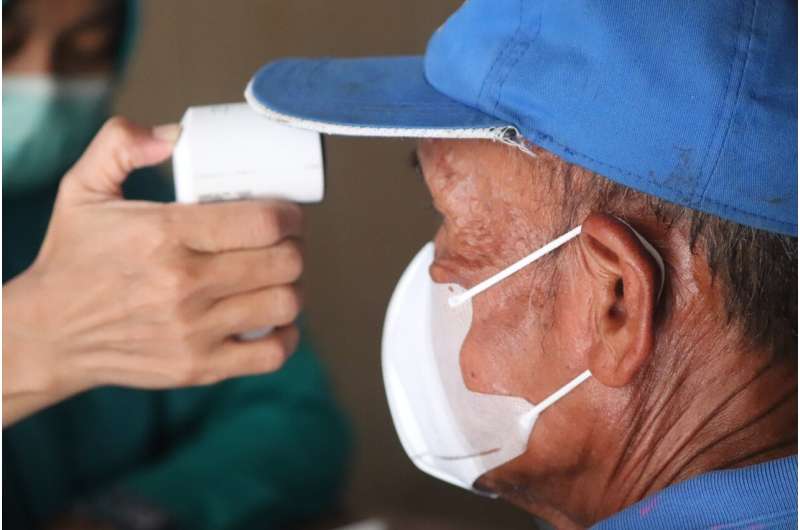What the 'let it rip' COVID strategy has meant for Indigenous and other immune-compromised communities

After a year and a half of lockdowns, border closures, mask-wearing and social distancing, and the vaccine rollout, Prime Minister Scott Morrison has shifted to what is essentially a "let it rip" pandemic approach.
This is a push from the government to "open up" and get "back to normal." However, since this approach was taken, it has led to omicron spreading at increased rates across the country.
This shift to "learning to live with the virus" makes life harder and more dangerous for vulnerable groups such as First Nations people, people living with disability, the elderly, those with chronic conditions and those who are immuno-compromised. Refugees and migrants are at also at higher risk of serious illness and death from COVID.
Experts warn: "As the virus moves into vulnerable populations, such as older Australians, people with disability and Aboriginal and Torres Strait Islander people […] we may see a rise in hospitalizations and death."
This way of thinking was especially prevalent in the discourse around the release of the Australian Bureau of Statistics COVID-19 mortality report. As reported in The Guardian, some media stated or implied COVID doesn't kill enough "healthy" people for it to be considered harmful, thus assigning lower value to certain lives.
For example Joe Hildebrand wrote in an op-ed for news.com.au: "…not only did so-called "COVID deaths" account for just 1% of fatalities during the pandemic, but 92% of that 1% were people with pre-existing health problems ranging from pneumonia to heart disease."
'Living with COVID' doesn't include everyone
In Australia, there are people with compromised immune systems who because of a chronic illness, can't be vaccinated. There are also some people whose bodies won't respond to COVID vaccines either because of medications for ongoing treatments, or co-morbidities that impact their immune system.
Even if people with chronic illness do get vaccinated, their compromised immune systems mean there is no certainty they would be protected from COVID.
The Australian Institute of Health and Welfare report Aboriginal and Torres Strait Islander people are impacted by disease 2.3 times more than non-Indigenous Australians.
GP and Epidemiologist Dr. Jason Agostino from Australian National University said: "there are almost 300,000 Aboriginal and Torres Strait Islander adults who are at higher risk of getting very sick if they are not vaccinated and get COVID-19."
ADF personnel have been called to assist with the outbreak, which has infected more than 70 residents and staff.
Via @hapsterpark https://t.co/XKzKS9gtDF
— NITV (@NITV) February 26, 2022
How First Nations communities are still being left behind
Before the pandemic, Aboriginal people faced health disadvantages and inequitable access to health care. This has worsened since the pandemic. One of the significant issues has been access to affordable food during the pandemic, increased vulnerability of homeless Indigenous people during lockdowns, lack of ability to self-isolate at home and lack of access to community healthcare.
The pandemic has also been disruptive to communities not being able to see one another because of public health concerns. This impacts community approaches to health care, cultural practices, and connection to country.
COVID-19 disrupts social fabric in the Kimberley as community transmission grows.https://t.co/i7JkEMfMM5
— ABC Indigenous (@ABCIndigenous) February 27, 2022
Some Indigenous communities also have limited access to health services and need to be better informed by health workers from their own communities about testing and vaccination. This was proven successful by stories such as in Arnhem Land, Mala'la Health Service's chairman Uncle Charlie Gunabarra traveled around remote communities sharing information about the COVID-19 vaccine. This led to a significant increase in vaccinations.
What needs to happen
A study by the Australian National University, the National Aboriginal Community Controlled Health Organization, the Royal Australian College of General Practitioners and the Lowitja Institute reinforces that First Nations people "must remain a priority group" for Australia's COVID-19 pandemic response.
In this study, Dr. Tanya Schramm from the Royal Australian College of General Practitioners said: "Improving access to social determinants such as housing and healthcare will reduce the risk of severe illness from COVID-19 among Aboriginal peoples, and this must occur alongside ongoing care and management of chronic conditions and efforts to increase vaccination coverage."
There have been efforts to overcome access to health services during the pandemic through telehealth and online healthcare options. However, there are challenges accessing these services such as limited access to phone, computer literacy and internet coverage. This also impacts refugee and migrant communities.
Despite Scott Morrision's statement "We're now at a stage of the pandemic where you can't just make everything free," not everyone can afford to buy rapid antigen tests. Although there are recent initiatives in place to make these available to concession card holders and to the WA population, these tests need to be free for all.
Ableism is complex, harmful, and the COVID-19 pandemic response has amplified harm to priority groups. In order to address this, the government needs to better include First Nations communities in their COVID-19 strategies going forward. This can be done by providing resources to Aboriginal community controlled health organizations in regional and remote areas, as recommended by the Australian Department of Health.
Better government support to and communication with First Nations people and their health centers can minimize misinformation and fear around the virus and vaccine. This could also provide much better access to health care, vaccines and rapid antigen tests.
As Western Australia opens up, some remote Indigenous communities and aged care facilities have been placed into lockdown, we need to find better ways to support vulnerable communities when addressing COVID-19 in Australia.
This article is republished from The Conversation under a Creative Commons license. Read the original article.![]()





















